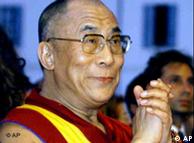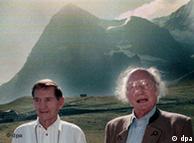
Austrian mountaineer who escaped wartime detention to spend seven years in Tibet
Both by choice and by fate, Harrer spent much of his life in the world’s mountainous regions. Born in Huttenberg, Austria, in 1912, he was educated at the University of Graz and first came to prominence as a member of the Austrian ski team in the 1936 Olympics. The following year he represented his country in the World Student Games, winning the downhill ski event. His prowess as a mountaineer led him naturally into full-time work as a guide and in 1938 he joined the four-strong team that was first to climb the North Wall of the Eiger.
The notorious Alpine face had repulsed numerous attempts and cost the lives of German and Austrian climbers. One mile high, swept by avalanche and rockfall and vulnerable to sudden storms, the Eiger Nordwand was deemed to be impossible to climb. This made the first successful ascent, under public scrutiny from the massed telescopes assembled at Kleine Scheidegg, a momentous and internationally significant achievement.
Harrer made no secret of his sympathy for National Socialism, and when in the same year Austria was absorbed into the Third Reich he was photographed with Hitler and, before cheering crowds, was congratulated by him on the successful climb. National Socialism closely associated itself with mountaineering and the sport became a useful allegory for the political goal Germany was striving towards.
Harrer enlisted in the Styrian SS as a sports teacher, an SS Oberscharführer with the rank of sergeant, which in the political circumstances of the day was probably the only way he would have been able to further his climbing career. With hindsight, he admitted, this had been “an unfortunate episode”.
In 1939 Harrer joined a German expedition to Nanga Parbat in the Himalayas, but on the outbreak of the Second World War was interned by the British at the Indian hill station of Dehra Dun as he returned from a reconnaissance of the mountain. Gazing across to the Himalayas beyond the prison wires, Harrer determined to escape and, after more than one abortive attempt, succeeded. With Peter Aufschnaiter, leader of the Nanga Parbat expedition, Harrer fled north towards Tibet.
After 21 months of march and counter-march, of great physical hardship and danger with the constant need “to keep the tongue subtle and the wits agile”, the pair arrived in Lhasa, unkempt but undefeated after crossing 20,000ft-high passes and the Clangthan plateau, a region infested by robbers.
Subtle tongue and agile wits led Harrer to the presence of the Dalai Lama, whose curiosity about the outside world he did his best to satisfy and to whom he became almost a tutor.
The idyll ended with the Chinese invasion of Tibet, when Harrer returned to a postwar, defeated Austria where he turned his experiences into the bestselling book Seven Years in Tibet.
The urge to explore was far from extinguished, and in later years Harrer returned to climb in the Himalayas and went on expeditions to Alaska, the Andes and the Ruwenzori “Mountains of the Moon” in Africa. He remained a keen and active skier into his eighties and, after taking up golf as a gentler sport in 1958, he became the Austrian amateur champion.
But Harrer’s past returned to haunt him when Seven Years in Tibet was made into a $70 million Hollywood epic starring Brad Pitt as Harrer. Following disclosures in the German magazine Stern, skeletons came tumbling from the cupboard and the commercial success of the film was threatened.
The Jewish lobby in Los Angeles threatened a boycott and the Simon Wiesenthal Centre gave warning that casting Pitt as Harrer, thereby boosting his hero status, could “whitewash the legacy of the Third Reich”. Some judicious editing by the director, Jean-Jacques Arnaud, made it clear that Harrer’s story began with a Nazi connection.
The more recent success of Jörg Haider, a keen mountaineer and leader of the Austrian Freedom Party, raised again the tight links that survive between sport and politics in Austria and the eagerness of the far Right to exploit, for political ends, Harrer’s image of the “comradeship of the rope”.
Harrer always insisted his conscience was clear and that many of the stories about his Nazi links were exaggerated or false, in particular that he had planted a swastika flag on the summit of the Eigerwand. “That’s made up. There was a blizzard; we could hardly keep our eyes open. We were covered with snow and just managed to shake hands and then we set off again,” he said in an interview on Austrian Radio.
Harrer called his Nazi membership “an ideological error” and “a stupid mistake”. The Nazi-hunter Simon Wiesenthal (obituary, September 21) said in an interview that Harrer was not involved in politics, and was not guilty of any wrongdoing. Even so, critics accused Harrer of attempting to conceal his past, while appearing unwilling to reject unequivocally the nationalist principles that led to the eventual horrors of Nazism.
Harrer was publicly criticised by Reinhold Messner, the celebrated Italian mountaineer, for stubbornly refusing to acknowledge the extent to which his ideal of the “rope for life”, along with his notion of being “tough as leather, hard as steel”, had been misused by the Nazis. Harrer may have been led astray, yet it remains that he made the hardest climb, and surely the most difficult journey, of his age.
As well as Seven Years in Tibet, Harrer wrote The White Spider, a history of the north face of the Eiger, and Tibet is My Country, the life story of the Dalai Lama’s eldest brother, Thubten Jigme Norbu.
He is survived by his third wife, Katharina (née Haarhaus).
Heinrich Harrer, mountaineer and explorer, was born on July 6, 1912. He died on January 7, 2006, aged 93.
Austrian explorer Heinrich Harrer's long and rocky life, from Hitler's elite SS guard to his friendship with the Dalai Lama and scores of high mountain passes in between, drew peacefully to an end at the weekend.
"He has set off calmly on his last expedition," his family said in a statement announcing the death of the 93-year-old, whose autobiography inspired the Hollywood film "Seven Years in Tibet", at a hospital in the town of Friesach in mountainous Carinthia province.
Born in Knappenberg in July 1912, Harrer first made his mark in mountaineering on July 24, 1938 as a member of a German-Austrian team that became the first to conquer the sheer 1,800 meter (5,900 foot) northern face of Switzerland's Mount Eiger.
 Bildunterschrift: Großansicht des Bildes mit der Bildunterschrift: Harrer and his team failed in their bid to climb Nanga Parbat.
Bildunterschrift: Großansicht des Bildes mit der Bildunterschrift: Harrer and his team failed in their bid to climb Nanga Parbat.
He joined a disastrous expedition by a German Nazi team the following year to the 8,114 meter Nanga Parbat mountain in Kashmir.
The group failed to reach the summit and was arrested by British forces days after the beginning of World War II in September 1939.
But it was not until nearly 60 years later that Harrer confirmed media reports he had been a member of the Nazi Party and was made an officer, thanks to the Eiger feat, in the feared Schutzstaffel paramilitary regiment after meeting Hitler.
He said he had a "clear conscience" as his role in the Nazi organization simply involved preparing for the Kashmir expedition.
Harrer also competed as a sprinter in the Austrian team at the 1936 Berlin Olympics.
War time escape led to two-year hike across Himalayas
The legend was forged in April 1944 when the mountaineer escaped from a British internment camp with expedition leader Peter Aufschnaiter and they spent nearly two years crossing the Himalayas by foot, traversing about 50 mountain passes more than 5,000 meters high.
The pair reached Lhasa in January 1946 and were to remain there until December 1950 before the Chinese army invaded Tibet.
Harrer developed a lifelong friendship with the Dalai Lama, then a boy, after being taken on to tutor him in affairs beyond the mountain kingdom.
Friendship and honors from Tibet
 Bildunterschrift: Großansicht des Bildes mit der Bildunterschrift: The Dalai Lama remained a friend of Harrer for most of his life.
Bildunterschrift: Großansicht des Bildes mit der Bildunterschrift: The Dalai Lama remained a friend of Harrer for most of his life.
The Dalai Lama visited Harrer twice at his home in Carinthia for his 80th and 90th birthdays in 1992 and 2002. Their final meeting was last summer when the Dalai Lama visited Germany to award a peace prize.
Recipient of a "Light of Truth" medal from the Tibetan government-in-exile, Harrer in May was due to lay the foundation stone of a 65 million euro European Tibetan Centre in his hometown. "Wherever I live, I shall feel homesick for Tibet," he wrote in the book about his Tibetan period.
Austrian Chancellor Wolfgang Schüssel said he was fascinated by the adventurer's life which included other expeditions to Latin America, Africa, the Arctic and the Pacific. "With Heinrich Harrer, mountaineering has lost a leading personality," he said.
The right-wing governor of Carinthia province, Jorge Haider, said Harrer was "an ambassador for peace and cohabitation between religions."

3 comments:
A peacemaker in our time who was able to say "I AM SORRY"
He certainly touched many peoples hearts, not least those of the people of Tibet and their ongoing plight!
As someone who was born in Klagenfurt myself to an Austrian mother and an English father, and who has also had the privilege of an adventurous life, I believe that Heinrich Harrer has done much to make the world a more peaceful place, not least in his country of birth Austria but also around the world.
A wise Aboriginee was aked how would you like to be remembered when referring to the indigenous aboriginee of Australia.
His response was to say, it is good for all of us to be able tell a good story, sing a song and to be able to dance.
Mr Harrer was able to do all of this.
Peter W Marshall
I was impressed with Peterwm60 description of Heinrich Harrer.I have found only a handful of articles that portray him in a good light,which he well deserves.
Most,try to make his short-lived time with the Nazi SS their main focus.We all have something we regret doing !
I have had the honor of meeting and working with many Tibetan Monks ,and if Mr.Harrer had been a evil man in anyway,he would not have been the tutor and life long friend to the Dalai Lama.
I am of like mind with Peter,concerning this extraordinary man Heinrich Harrer.And ,yes ,Mr.Harrer was able to apologize, tell a good story,sing a song and he danced on the mountains tops of the world and most definitely helped make this world a more peaceful place.And I know he, too ,has found his peace. R.E.D.
I now know his history, but what were his spiritual beliefs, and political affiliations? Nice, polite, and well mannered people could also have pretty radical political beliefs. Did he sympathize with antisemitism? It interests me, because he was portrayed as a hero in Nazi media, and didn't seem to reject their support, and governments. It also interests me because he was the tutor of the 14th dalai lama! If he has the same nationalistic, oppressive, and racist views of the Nazis, did he pass those on to the dalai lama?! You could be all about peace, but still want to be the ruler of your own country. Dictators are sneaky.
Post a Comment